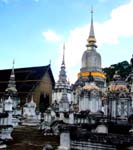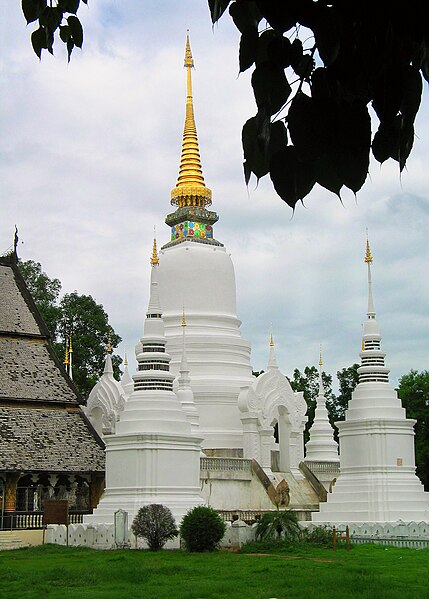Wat Suan Dok, Chiang Mai
The fourteenth century temple of Wat Suan Dok is located just west of the old city walls on Suthep Road. The temple was built by King Keu Na of Lanna for a revered priest visiting from Sukhothai as a place for the monk to spend the rains retreat. The name of the temple roughly translates to "field of flowers."There are several unique features to this temple that you won't see in just about any other wat around Chiang Mai, or even elsewhere in Thailand. One of the first is the temple's large wiharn, or prayer hall. The chapel is unusual not only for its size, but also the fact that it is open on the sides rather than being totally enclosed.
Directly west of the wiharn are several large pagodas, called chedi in Thai. The largest of these is the center of another unusual story. Pagodas will almost always contain Buddhist relics. The biggest and most important chedis will contain a relic of the Buddha himself. In the case of Suan Dok, the largest stupa contained a relic that reputedly self-replicated. One of the relics was placed on the back of a royal white elephant, which was then allowed to wander where-ever it wanted to go.
 Reliquaries of the past rulers of Chiang Mai. |
Next to the pagoda is a veritable forest of ornate white-washed reliquaries. This "city of the dead" houses the cremated remains of the rulers of Chiang Mai. Walking among these elaborate monuments, you could easily be reminded of the famous above-ground cemeteries of New Orleans.
Wat Suan Dok is also a temple where you can try to learn more about Buddhism, through their "monk chat" program. At certain times, and on certain days of the week, you can talk with a Buddhist monk. This program is in part a chance for monks to practice their English skills, so don't expect fluent conversation.
History
Wat Suan Dok was founded by King Kue Na of Lanna for the monk Sumana Thera in the year 1370 CE. The temple was built in the centre of Wiang Suan Dok (Thai: เวียงสวนดอก), a walled settlement (Wiang, Thai: เวียง) of the Lawa people older than Chiang Mai itself. The outlines of the fortifications can clearly be traced on satellite images, and remains of some of the earthen walls can still be seen north of Suthep road. King Kue Na's flower garden (Thai: สวนดอกไม้, suan dok mai), which was located here, lent the temple its original name: Wat Buppharam Dok Mai (Thai: วัดบุปผารามดอกไม้), or Wat Suan Dok Mai (Thai: วัดสวนดอกไม้) for short.According to legend, Maha Sumana Thera, a monk from the Sukhothai Kingdom, after having had a vision discovered a relic of the Buddha which, also according to the same vision, was to be housed in Chiang Mai. Sumana Thera stayed two rainy seasons at Wat Phra Yuen just outside Lamphun at the invitation of King Kue Na while the latter had Wat Buppharam Dok Mai built. When the moment arrived for the relic to be housed in the newly built temple, it miraculously duplicated itself. One of the relics was housed, as intended, in a shrine inside Wat Buppharam Dok Mai, while the other relic was placed on the back of a white elephant which then climbed up Doi Suthep, the mountain directly west of Chiang Mai, where it trumpeted three times and died. Wat Phrathat Doi Suthep was built on that spot to house the second relic.
Sights
- The large 48 meter high bell shaped chedi - built in a Sri Lankan style - can be seen from far. The relic of the Buddha is said to be contained within. Stairs on all four sides originally led up to the narrow terrace encircling the chedi but these have since been replaced by ramps, the balusters of which are decorated with seven-headed nāgas emerging from the mouths of makaras, as is typical for the classic Lanna style.
- The large sala kan prian (Thai: ศาลาการเปรียญ, sermon hall) is located directly east of the main chedi. It was built in 1932 by the famous monk Phra Krubra Srivichai, who also had an ubosot built as well as the main chedi restored. The main Buddha statues inside the sala kan prian are placed so that they look out at opposite directions. The statue of the Buddha seated in meditation (Bhumisparsha Mudrā) looks towards the east, whereas the other statue, a standing Buddha holding a bundle of straw, faces west towards the chedi. Placed in front of the seated statue one finds a smaller Buddha in the Lanna style, created during King Kue Na's time. The feet of this statue are unusual in that the toes are - influenced by Sri Lanka - individually formed. Flanking the images are more statues of the Buddha, some of which are from the 1930s.
- The recently renovated ubosot contains a 4.70 m (15.4 ft) high bronze Buddha statue in the Bhumisparsha-Mudra posture, which was caste in 1504 CE during the rule of King Mueang Kaeo. The statue, which carries the name Phra Chao Kao Tue, is remarkable in that the fingers of the Buddha are all of the same length, indicative of influence from Sukhothai, but with robes depicted in the style of the Ayutthaya Kingdom.
- A grouping of white washed mausoleums, which house the cremation ashes of members of the royal family of Chiang Mai, is located in the northwestern quarter of the temple grounds. At the beginning of the 20th century, Princess Dara Rasmi, one of the wives of King Chulalongkorn (Rama V) and daughter of the Lanna king Inthawichayanon, had the ashes collected from around Chiang Mai to be interred at their present setting.
Videos
Map
ดูแผนที่ขนาดใหญ่ขึ้น
Gallery
http://thailandforvisitors.com/north/chiangmai/cm-temps.html




No comments:
Post a Comment